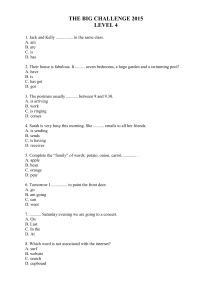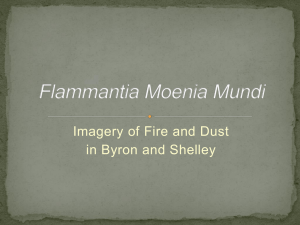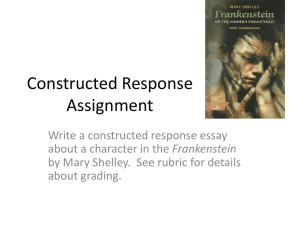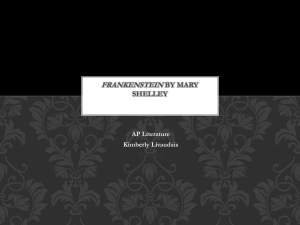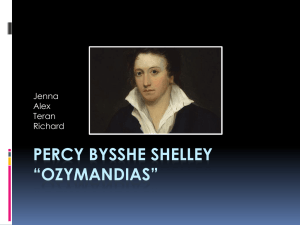TREASURE OF THE MONTH - DECEMBER
advertisement
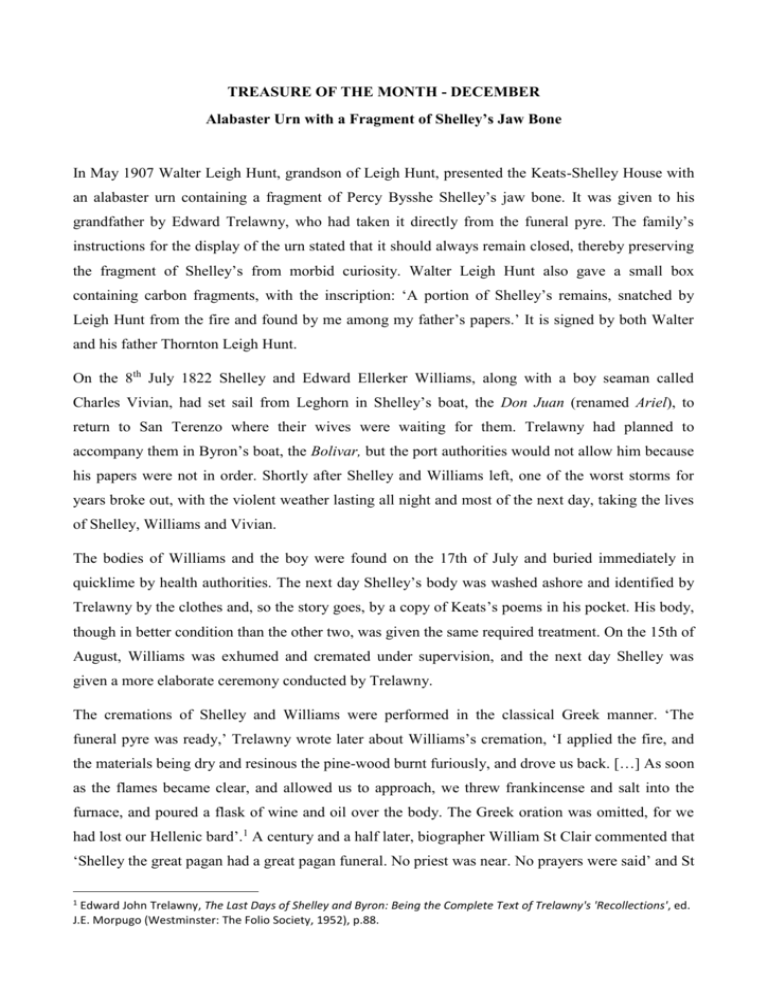
TREASURE OF THE MONTH - DECEMBER Alabaster Urn with a Fragment of Shelley’s Jaw Bone In May 1907 Walter Leigh Hunt, grandson of Leigh Hunt, presented the Keats-Shelley House with an alabaster urn containing a fragment of Percy Bysshe Shelley’s jaw bone. It was given to his grandfather by Edward Trelawny, who had taken it directly from the funeral pyre. The family’s instructions for the display of the urn stated that it should always remain closed, thereby preserving the fragment of Shelley’s from morbid curiosity. Walter Leigh Hunt also gave a small box containing carbon fragments, with the inscription: ‘A portion of Shelley’s remains, snatched by Leigh Hunt from the fire and found by me among my father’s papers.’ It is signed by both Walter and his father Thornton Leigh Hunt. On the 8th July 1822 Shelley and Edward Ellerker Williams, along with a boy seaman called Charles Vivian, had set sail from Leghorn in Shelley’s boat, the Don Juan (renamed Ariel), to return to San Terenzo where their wives were waiting for them. Trelawny had planned to accompany them in Byron’s boat, the Bolivar, but the port authorities would not allow him because his papers were not in order. Shortly after Shelley and Williams left, one of the worst storms for years broke out, with the violent weather lasting all night and most of the next day, taking the lives of Shelley, Williams and Vivian. The bodies of Williams and the boy were found on the 17th of July and buried immediately in quicklime by health authorities. The next day Shelley’s body was washed ashore and identified by Trelawny by the clothes and, so the story goes, by a copy of Keats’s poems in his pocket. His body, though in better condition than the other two, was given the same required treatment. On the 15th of August, Williams was exhumed and cremated under supervision, and the next day Shelley was given a more elaborate ceremony conducted by Trelawny. The cremations of Shelley and Williams were performed in the classical Greek manner. ‘The funeral pyre was ready,’ Trelawny wrote later about Williams’s cremation, ‘I applied the fire, and the materials being dry and resinous the pine-wood burnt furiously, and drove us back. […] As soon as the flames became clear, and allowed us to approach, we threw frankincense and salt into the furnace, and poured a flask of wine and oil over the body. The Greek oration was omitted, for we had lost our Hellenic bard’.1 A century and a half later, biographer William St Clair commented that ‘Shelley the great pagan had a great pagan funeral. No priest was near. No prayers were said’ and St 1 Edward John Trelawny, The Last Days of Shelley and Byron: Being the Complete Text of Trelawny's 'Recollections', ed. J.E. Morpugo (Westminster: The Folio Society, 1952), p.88. Clair praises Trelawny for turning what could have been an unpleasant ordeal into ‘an unforgettable drama’.2 According to the legend inaugurated by Trelawny’s account of the cremation, when Shelley’s body was burned on the beach near Viareggio ‘the only portions that were not consumed were some fragments of bones, the jaw, and the skull, but what surprised us all, was that the heart remained entire’.3 Trelawny says that he snatched the heart from the furnace, severely burning his hand in the process. Shelley’s heart was taken by Leigh Hunt who later gave it to Mary Shelley, the poet’s second wife, at her own insistence. Mary treasured the heart, keeping it in a silken sack between the leaves of Shelley’s elegy Adonais, which he wrote upon the death of Keats. Shelley’s heart was finally buried in 1889, 67 years after his death, with the body of his son Sir Percy Florence Shelley. Meanwhile, Trelawny retained the fragments of bone, and for the rest of his life delighted in showing them to people. The urn in the Keats-Shelley House contains a fragment of Shelley’s jaw bone given by Trelawny to Leigh Hunt, and kept in the family as a sacred relic. Hunt’s wife Marianne fondly referred to it in a journal entry of 18 September 1882: ‘I look at my little box and think of the lip that covered what it contains until I can bear it no longer. A lip from whence every pure and generous feeling issued daily, hourly, & momentarily. But I must not think on it’. Some may find the idea of keeping body parts as relics rather gruesome. However, it was once a common custom all over Europe and especially in Italy, where Christian relics have been preserved in churches. Bodily fragments of important people from secular fields are also housed and displayed in museums, an example being Galileo Galilei’s index finger, which belongs to the collection of the Istituto e Museo di Storia della Scienza di Firenze. Nevertheless, the fact that so many relics of Shelley’s life still remain in the Keats-Shelley House, where the urn containing the piece of jawbone is displayed alongside locks of his hair and other fragments from his life, is a testament to his legacy. By Emily Arbis, MSt student in Art History and Visual Culture at Oxford University and Keats-Shelley House Research Intern, August 2014. 2 3 William St. Clair, Trelawny: The Incurable Romancer (London : John Murray, 1977), p.82. Edward John Trelawny, Op. Cit., p.90.

